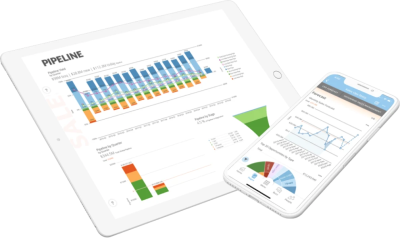7 ways to boost sales team success with BI
Sales data is extremely useful for measuring the performance of your sales team and analyzing how you can improve your processes. However, understanding how to analyze sales data in a way that leads to action isn’t always easy.
Many businesses are using analytical tools to track the performance of their sales team, which is a significant first step towards optimizing company performance.
The difficulty comes in interpreting that data so that it helps improve sales processes and increase revenue. If you currently have access to your company’s sales data but aren’t sure how to best use it, this article will give you tips on how to analyze it for maximum effectiveness.
What is sales analytics?
Sales analytics is the process of analyzing sales data in order to improve sales processes and increase revenue. This can be done by using BI-driven sales intelligence tools, which identify areas of improvement.
BI software allows businesses to analyze their sales data in a number of different ways, including:
- Comparing current performance against past performance.
- Identifying trends.
- Measuring customer satisfaction levels.
- Assessing the effectiveness of marketing campaigns.

Seven tips for BI-driven sales team success
Sales data is only as good as the team that’s supposed to use it. In many businesses, the problem isn’t that sales fundamentals are struggling; it’s that sales teams aren’t using data to drive their decision-making.
To boost your sales analytics success, you have to boost the success of your sales team. You need to give your sales team the tools they need to succeed, otherwise all that sales analytics will be for nothing.
Here are seven tips for ensuring sales team success:
1. Define what you’re looking for before diving into the data.
The most important part of analyzing sales data is to be very specific about what you’re looking for. The more specific you can be about what you’re trying to understand and where you expect to find those answers, the more effective the analysis will be.
You should define those questions before you start digging into the data so that you’re not just aimlessly scrolling through numbers and hoping to find something useful. It’s not enough to say ‘let’s boost sales’; you need goals that are clear, actionable, and achievable.
Have a specific goal in mind and try to find data points that support that goal. This can help you focus your attention on the most important information and avoid getting distracted by other, less important data.
For instance, if you’re trying to understand why your sales have been declining, you might want to look at data points such as:
- The number of leads generated
- The number of sales meetings set up
- The conversion rate
- The average deal size
2. Track the same data for all of your sales teams and apply it equally to all team members.
One mistake that many businesses make when analyzing sales data is treating each sales team differently when tracking key metrics.
For example, if you’re measuring the number of sales each salesperson makes per week and one of your sales teams had a really slow week, it can be tempting to give them a sales quota lower than the sales quota for the other teams.
This can be especially tempting if one sales team has a very successful week while another team hasn’t had as much success. However, you’re not treating all team members equally when you do this. You’re not measuring each sales team member’s productivity based on the average productivity of that sales team.
Instead, you’re essentially punishing or rewarding each team member based on their individual performance instead of the average performance of their team. Rather than doing this, you should be tracking the same data for all sales teams and applying it equally to all team members.

3. Track key metrics to understand how much each member contributed to your total sales.
An essential step in analyzing sales data is tracking key metrics based on the data you have.
For example, you can track your lead generation metrics in real-time throughout the week. Not only does this allow your sales team to get a good sense of how they’re doing, it allows managers to judge the likelihood of goal attainment.
From there, you can do other things with that data. For instance, you could compare your current metrics to your previous week’s metrics to see whether things are trending up or down week-over-week.
Based on your sales metrics, you can then determine which strategies are generating the most sales and which ones are generating the least. Then you can work with your team members to help them improve their performance.
4. Monitor your most important sales channels and track how many leads come from each one.
Sales channels are the paths your sales team uses to generate leads and generate sales.
For example, if you sell a product online, one of your sales channels is your website. If you use social media to promote your products, one of your sales channels is social media. Monitoring the most important sales channels and tracking how many leads come from each one can help you determine which sales channels are most effective and which sales channels you may want to focus on more.
This can be especially helpful if you’re using multiple sales channels. Comparing the number of leads each sales channel is generating can help you determine which channels are most effective. Then you can focus your attention on those channels and generate more leads from them.
5. Track your costs
When monitoring the most important sales channels, be sure to track how many leads come from each one and any costs associated with running that sales channel.
If you’re paying for ads on social media and the number of leads coming from that channel is lower than the number of leads coming from your website, that doesn’t necessarily mean that social media isn’t an effective sales channel. It may just mean that the ads you’re running on social media cost more than those on your website. Then you can decide if the investment is worth it.

6. Spot broad, time-based trends.
Another important piece of analyzing sales data is noting which days, times, or events are your most productive. This is essential for a few reasons.
First, if you know when your team is the most productive, you can adjust your sales goals accordingly. For example, if you know that your team is more productive in the morning, you may want to set a goal for them to generate more leads during that time period.
Second, if you know when your team is the least productive, you can take steps to address that. For example, if you know that your team is less productive on Fridays, you may want to brainstorm ways to increase their productivity or motivation.
By taking note of these patterns, you can more effectively manage your sales team and help them reach their potential.
Beyond improving your sales team, monitoring these sorts of time-based trends is very important to sales success. The classic example is how sales for summer-related goods like swimsuits and lawn chairs jump in late May but drop again in early September.
Don’t be the company trying to sell snow shovels in June. Look at these trends and make sure you’re marketing and selling your products at the times when they’re going to sell the best.
7. Regularly review your sales data and make changes based on what you find.
The final step in effectively analyzing your sales data is to regularly review it and make changes based on what you find.
This doesn’t mean that you need to constantly be making changes to your sales strategy. But it does mean that you should periodically review your sales data and make adjustments as needed.
For example, if you find that your team’s productivity has decreased since you last reviewed the data, you may want to brainstorm ways to increase their motivation or make changes to the sales goals.
On the other hand, if you find that your team is consistently meeting or exceeding their sales goals, you may want to set higher goals for them.
Regularly reviewing your sales data and making changes based on what you find is the best way to ensure that your team is as productive as possible and that your business is reaching its full potential.
The bottom line
Sales data can be extremely useful for measuring your sales team’s performance and analyzing how you can improve your processes.
The most important part of this process, however, is to be very specific about what you’re looking for and to calculate key metrics based on the data you have. By analyzing sales data, you can better understand how your sales team is performing and where there are opportunities for improvement.
When it comes to combining the power of BI tools with the rich data that’s generated by your sales team, you need to make sure you’re using the right tools for the job. Only then can you take the steps necessary to improve your sales process and reach your full potential.
Check out some related resources:

The 11 Best Big Data Analytics Tools in 2025

Business Intelligence Strategy: Development, Best Practices, and Examples






